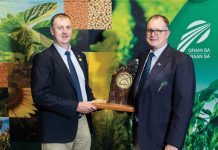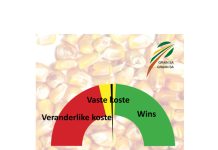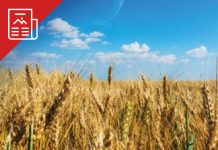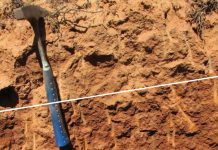



Scientific name: Xanthium strumarium
Afrikaans name: Kankerroos
English name: Cocklebur
Short description
Cocklebur is a branched, semi-herbaceous, annual plant, growing up to 1,5 m high, of which the seedlings are particularly poisonous.
Adult plants have deep, sturdy taproots and stems are reddish brown with red speckles which make them appear coarse. Leaves are simple, alternately arranged, egg-shaped (ovoid) to heart-shaped (cordiform) and sawed (serrate) margins.
Fruits are produced in distinctive axillary achenes, up to 2 cm long, brown, woody, crowned with two sturdy horns and covered with hooked spines that can easily cling to clothes and the coats of animals. Seeds are two per fruit, one larger than the other, blackish, ovally flattened, up to 1,5 cm long.
Distribution
Cocklebur is a strong competitor. It is known for its strong competitive effect on annual crops. Seeds can be dormant in the soil for long periods due the size of the seeds and can germinate from deep burial depths. It reproduces via seed only, is a large-seeded, deep germinator and are widespread in southern Africa.
Control
Cultivation
Shallow cultivation after emergence of seedlings can give effective control.
Chemical
Although a number of pre-emergence herbicides are registered for control of cocklebur in maize and wheat, control is erratic. Post-emergence herbicides give more effective control. Effectivity of herbicides decreases as the plants grow bigger and time of application is therefore crucial. Strictly follow the specific instructions and dosages on the label of each product.
Always contact a reliable chemical advisor before using any chemicals to ensure the correct dosage and specifications on the label are adhered to.
TABLE 1: Herbicides registered for the control of cocklebur in maize.
| Active Ingredient | Formula | Time of Application |
|---|---|---|
| 2,4-D | 480 g/litre | Pre-emergence application within five to six days after planting Post-emergence when crop is 30 cm tall, otherwise use drop arms for directed spray |
| 2,4-D/dicamba | 240/80 g/litre | Post-emergence, when weeds are actively growing, five to six leaf stage |
| acetochlor/atrazine/terbuthylazine | 125/187/187 g/litre 150/225/225 g/litre 200/150/150 g/litre 250/225/225 g/litre 250/250/225 g/litre 350/175/175 g/litre | Pre-emergence, with plant or within three days after planting Early post-emergence application, not later than four leaf stage of the weed |
| atrazine/cyanazine | 167/333 g/litre 250/250 g/litre | Pre-emergence or early post-emergence |
| atrazine/mesotrione/s-metolachlor | 208,5/26,8/208,5 g/litre | Pre-emergence application |
| atrazine/sulcotrione | 300/125 g/litre | Pre- or post-emergence application |
| atrazine/terbuthylazine | 250/250 g/litre 300/125 g/litre 300/300 g/litre 450/450 g/kg | Pre-emergence or post-emergence, before four leaf stage of the weed |
| bendioxide | 480 g/litre | Post-emergence application |
| bromoxynil | 225 g/litre. 400 g/litre 450 g/litre 500 g/litre | Post-emergence application, between four to six leaf stage of the weed |
| bromoxynil/terbuthylazine | 150/333 g/litre | Post-emergence application |
| dicamba | 480 g/litre 700 g/kg | Post-emergence, till crop is 30 cm tall |
| dicamba/topramezone | 160/50 g/litre | Early post-emergence, before six leaf stage of the weed, use in tank mix with atrazine or atrazine/terbuthylazine |
| flumetsulam | 800 g/kg | Pre-emergence, use in tank mix with metolachlor or s-metolachlor |
| glyphosate/mesotrione/s-metolachlor | 250/25/250 g/litre | Post-emergence, only on glyphosate-tolerant cultivars |
| halosulfuron | 750 g/kg | Post-emergence application |
| MCPA | 400 g/litre 700 g/kg | Pre-emergence, within five to six days after planting Post-emergence, till crop is 30 cm tall |
| mesotrione | 480 g/litre | Pre- or post-emergence Use only in tank mixes with atrazine, atrazine/ terbuthylazine,or s-metolachlor |
| mesotrione/s-metolachlor | 83,3/416,7 g/litre | Pre-emergence application |
| s-metolachlor | 915 g/litre 960 g/litre | Pre-emergence application, within three days after planting |
| s-metolachlor/terbuthylazine | 102,8/497,2 g/litre 312,5/187,5 g/litre | Pre-emergence application Early post-emergence, in tank mixes with mesotrione |
| metribuzin | 480 g/litre | Post-emergence, between four to six leaf stage of weed, in tank mix with 2,4-D or bromoxynil |
| topramezone | 336 g/litre | Early post-emergence application, before six leaf stage of the weed, in tank mix with atrazine or atrazine/terbuthylazine |
TABLE 2: Herbicides registered for the control of cocklebur in wheat.
| Active ingredient | Formula | Time of application |
|---|---|---|
| 2,4-D | 480 g/litre 500 g/litre | Apply between growth stages seven to thirteen of the crop |
| 2,4-D/dicamba | 240/80 g/litre | Post-emergence application, when weeds are actively growing, five to six leaf stage |
| bendioxide | 480 g/litre | Apply on young, actively growing weeds |
| bromoxynil | 225 g/litre 255 g/litre 400 g/litre 450 g/litre 500 g/litre | Post-emergence application, when weed are between leaf stages four to six |
| dicamba | 700 g/kg | Only in tank mixes with Enhancer (10 g - 12 g) + Reaper (10 g) + adjuvant |
| halosulfuron | 750 g/kg | Post-emergence |
| MCPA | 400 g/litre 700 g/kg | Apply between growth stages seven to 13 of the crop |
Contact the writers at elbe.hugo@syngenta.com (Elbe Hugo) and deweth@arc.agric.za (Hestia Nienaber).

















